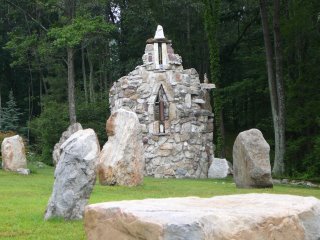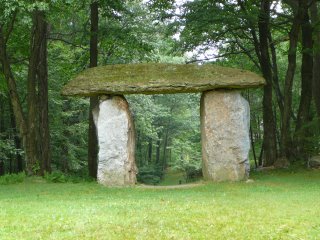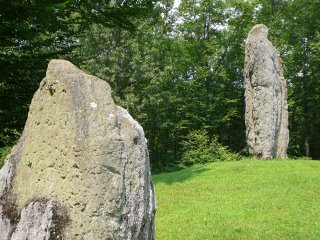
A friend, Susan, read the newspaper article that led six Red Hat friends and I to pick a beautiful summer day, rent a van, and follow winding Route 94 through the green farmland, rural communities, and small towns of New Jersey and Pennsylvania to Columcille in Bangor, PA.
This peaceful preserve, located on seventeen acres of calmly meandering trails through verdant woods, is special in its serenity.
Since 1979, Fred Lindkvist and Bill Cohea have been creating Columcille as a restorative sanctuary—a place of serenity, a place of myth and mystery. Indeed, the word “Columcille, ” meaning “dove of the Church” is the Irish nickname for St. Columba, the Irish Celtic Monastic who founded the monastery on the island of Iona. Columcille is a unique combination of myriad beliefs. Just go with it and find peace is probably a good motto for the place. Look at this invitation from the brochure.
******************************
The Stones of Columcille
“Myth and Mystery”
Stones are guides and connect
To the Source of Creation in the
Beginning timeless spirit
Of consciousness.
Joining stars to stars,
Age to age.
Come dance with the stones.
Touch them.
Hear their songs.
Prepare to enter realms unknown.
Journey well.
And may the Spirit of
Oneness of all
Awaken your memory
And connect you to the
Mysterious Source.
Enter through the Infinity Gate
And journey at your own risk.
The Stones of Columcille
“Myth and Mystery”
Stones are guides and connect
To the Source of Creation in the
Beginning timeless spirit
Of consciousness.
Joining stars to stars,
Age to age.
Come dance with the stones.
Touch them.
Hear their songs.
Prepare to enter realms unknown.
Journey well.
And may the Spirit of
Oneness of all
Awaken your memory
And connect you to the
Mysterious Source.
Enter through the Infinity Gate
And journey at your own risk.
***************************
Sounds intriguing? We thought so.
We enter Columcille to be greeted by a swirling array of variously colored butterflies hovering over the flowering butterfly garden. Smiles all around.
Before us is the Circle of Stones placed in an open field to connect the energies. At one point just outside the circle is the St. Oran Bell Tower, a high stone concentric structure purposefully left unfinished and open to the sky, and hence, to the realm of possibility. It does not take us long to fall under the spell of Columcille.
Beyond the Circle of Stones lead paths through the woods, serpentine walkways which somehow cause us to stop and listen to the quiet and peace. There’s not much opportunity to do that in the world, and Anne notes that if she lived closer to Columcille, she might be inclined to linger with a good book on one of the stone benches placed along the paths to allow journeyers a moment’s pause.
Eileen and I stop by the wayside to ring the sweetest, melodious bells. We listen as their music wafts away, echoing in the woods, breaking the silence but in no way breaking the peace.
 We stop to enter St. Columba Chapel. The stone in the center of this small, round building with its heavy, carved wooden door is the Stone of “Centering and Grounding.” It is cool and serene inside; lighted votive candles flicker. Lining the walls are stone benches—places to sit and contemplate.
We stop to enter St. Columba Chapel. The stone in the center of this small, round building with its heavy, carved wooden door is the Stone of “Centering and Grounding.” It is cool and serene inside; lighted votive candles flicker. Lining the walls are stone benches—places to sit and contemplate.
We climb the hill to the most familiar structure, Thor’s Gate, Guardian of the North Wind, the “Mighty Wind of Voyage.” Thor’s Gate is reminiscent of the stones of Stonehenge (or the blocks of Foamhenge in VA). We can’t resist pretending to pose beneath, spreading our arms out from our shoulders pretending to be Samsons! We can only be quiet and well-behaved for so long!
Picking up our pace a bit and becoming less focused and serious, we head to the labyrinth, making some irreverent Harry Potter jokes, chuckling a bit, and walking the stone maze, looking with, I must admit, raised eyebrows, at the odds and ends left on the “altar” in the center. It’s a bit difficult to keep seven girlfriends on a totally quiet and serious tack.
As we enter the woods again, we have a choice of paths. We select one and soon find our orienteering skills are sorely lacking, and we miss or circumvent the stones we seek. We decide to try again after lunch.
At lunch we meet the gentlemen (and their dog) who have sculpted this garden, Fred and Bill, and we spend a lovely time with them as they feed the koi in the pond and share some of their history with us.
Later we decide to try again to find The Sacred Women’s Site, but we leave Carol behind to fulfill her contemplative urge with a book of psalms.
We find our way successfully this time, experience a kind of wonder as we see other stones in the woods, and climb back out to emerge in an open, grassy space where high, stone monoliths impress with their strength. Our emergence from the dark, leafy world of woods to this green field, natural yet unnatural as host to the stone intruders—or not—create strange feelings. There is a sense of wonder all around us, and we have to stop and inhale deeply, taking in our surroundings through every pore. Beautiful and new. Happy.
Our emergence from the dark, leafy world of woods to this green field, natural yet unnatural as host to the stone intruders—or not—create strange feelings. There is a sense of wonder all around us, and we have to stop and inhale deeply, taking in our surroundings through every pore. Beautiful and new. Happy.
If you cannot visit Columcille, go to their website and explore it that way. What Rich and Bill call a sacred space is a mixture of so many primordial beliefs. They invite all to visit. They invite all to join the Company of Columcille and help in their commitment to “mentoring the land and those who pass through it.” Columcille, BTW, is free for all to visit, but you will want to leave a well-deserved donation to this good place.
Sounds intriguing? We thought so.
We enter Columcille to be greeted by a swirling array of variously colored butterflies hovering over the flowering butterfly garden. Smiles all around.
Before us is the Circle of Stones placed in an open field to connect the energies. At one point just outside the circle is the St. Oran Bell Tower, a high stone concentric structure purposefully left unfinished and open to the sky, and hence, to the realm of possibility. It does not take us long to fall under the spell of Columcille.
Beyond the Circle of Stones lead paths through the woods, serpentine walkways which somehow cause us to stop and listen to the quiet and peace. There’s not much opportunity to do that in the world, and Anne notes that if she lived closer to Columcille, she might be inclined to linger with a good book on one of the stone benches placed along the paths to allow journeyers a moment’s pause.
Eileen and I stop by the wayside to ring the sweetest, melodious bells. We listen as their music wafts away, echoing in the woods, breaking the silence but in no way breaking the peace.
 We stop to enter St. Columba Chapel. The stone in the center of this small, round building with its heavy, carved wooden door is the Stone of “Centering and Grounding.” It is cool and serene inside; lighted votive candles flicker. Lining the walls are stone benches—places to sit and contemplate.
We stop to enter St. Columba Chapel. The stone in the center of this small, round building with its heavy, carved wooden door is the Stone of “Centering and Grounding.” It is cool and serene inside; lighted votive candles flicker. Lining the walls are stone benches—places to sit and contemplate.We climb the hill to the most familiar structure, Thor’s Gate, Guardian of the North Wind, the “Mighty Wind of Voyage.” Thor’s Gate is reminiscent of the stones of Stonehenge (or the blocks of Foamhenge in VA). We can’t resist pretending to pose beneath, spreading our arms out from our shoulders pretending to be Samsons! We can only be quiet and well-behaved for so long!

Picking up our pace a bit and becoming less focused and serious, we head to the labyrinth, making some irreverent Harry Potter jokes, chuckling a bit, and walking the stone maze, looking with, I must admit, raised eyebrows, at the odds and ends left on the “altar” in the center. It’s a bit difficult to keep seven girlfriends on a totally quiet and serious tack.
As we enter the woods again, we have a choice of paths. We select one and soon find our orienteering skills are sorely lacking, and we miss or circumvent the stones we seek. We decide to try again after lunch.
At lunch we meet the gentlemen (and their dog) who have sculpted this garden, Fred and Bill, and we spend a lovely time with them as they feed the koi in the pond and share some of their history with us.
Later we decide to try again to find The Sacred Women’s Site, but we leave Carol behind to fulfill her contemplative urge with a book of psalms.
We find our way successfully this time, experience a kind of wonder as we see other stones in the woods, and climb back out to emerge in an open, grassy space where high, stone monoliths impress with their strength.
 Our emergence from the dark, leafy world of woods to this green field, natural yet unnatural as host to the stone intruders—or not—create strange feelings. There is a sense of wonder all around us, and we have to stop and inhale deeply, taking in our surroundings through every pore. Beautiful and new. Happy.
Our emergence from the dark, leafy world of woods to this green field, natural yet unnatural as host to the stone intruders—or not—create strange feelings. There is a sense of wonder all around us, and we have to stop and inhale deeply, taking in our surroundings through every pore. Beautiful and new. Happy.If you cannot visit Columcille, go to their website and explore it that way. What Rich and Bill call a sacred space is a mixture of so many primordial beliefs. They invite all to visit. They invite all to join the Company of Columcille and help in their commitment to “mentoring the land and those who pass through it.” Columcille, BTW, is free for all to visit, but you will want to leave a well-deserved donation to this good place.









